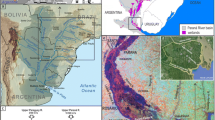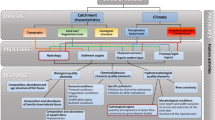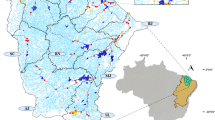Abstract
The increasing frequency of extreme events in large rivers may affect not only their flow, but also their water quality. In the present study, spatial and temporal changes in fluvial physico-chemical variables were analyzed in a mega-river delta during two extreme hydrological years (La Niña-El Niño) and related to potential explanatory factors. Basic water variables were evaluated in situ at 13 points (distant 2–35 km from each other) in watercourses of the Delta Biosphere Reserve (890 km2) in the Lower Paraná River (Argentina) in nine surveys (October 2008–July 2010) without meteorological tides. Samples for laboratory analyses were collected from each main river. Multivariate tests by permutations were applied. The period studied was influenced by a drought, within a long period dominated by low flows combined with dry weather and wildfires, and a large (10 years of recurrence) and prolonged (7 months) flood. The hydrological phase, followed by the season and the hydrological year (according to the ENSO event) were the principal explanatory factors of the main water quality changes, whereas the drainage sub-basin and the fluvial environment (river or stream) were secondary explanatory factors. During the drought period, conductivity, turbidity, and associated variables (e.g., major ions, silicon, and iron concentrations) were maximal, whereas real color was minimal. In the overbanking flood phase, pH and dissolved oxygen concentration were minimal, whereas real color was maximal. Dissolved oxygen saturation was also low in the receding flood phase and total major ion load doubled after the arrival of the overbanking stage. The water quality of these watercourses may be affected by the combination of several influences, such as the Paraná River flow, the pulses with sediments and solutes from the Bermejo River, the export of the Delta floodplain properties mainly by the flood, the season, and the saline tributaries to the Lower Paraná River. The high influence of the hydrology of this large river on the Delta fluvial water quality emphasizes the relevance of changes in its flow regime in recent decades, such as the seasonality attenuation. Considering that the effects of extreme events differ among and within fluvial systems, specific ecohydrological evaluations and powerful appropriate statistics are key tools to gain knowledge on these systems and to provide bases for suitable management measures in a scenario of climate change and increasing human alterations and demands.







Similar content being viewed by others
References
Amsler L, Drago EC (2009) A review of the suspended sediment budget at the confluence of the Paraná and Paraguay Rivers. Hydrol Process 23:3230–3235
Anderson MJ (2006) Distance-based tests for homogeneity of multivariate dispersions. Biometrics 62:245–253
APHA, AWWA, WEF (2005) Standard methods for the examination of water and wastewater, 21st edn. American Public Health Association, Washington DC
Baigún CR, Puig A, Minotti PG, Kandus P, Quintana R, Vicari R, Bo R, Oldani NO, Nestler JA (2008) Resource use in the Paraná River Delta (Argentina): moving away from an ecohydrological approach? Ecohydrol Hydrobiol 8:245–262
Bonetto C, Villar C, de Cabo L, Vaithiyanathan P (1998) Hydrochemistry of a large floodplain river. Verh Internat Verein Limnol 26:899–902
Borcard D, Legendre P, Drapeau P (1992) Partialling out the spatial component of ecological variation. Ecology 73:1045–1055
Borcard D, Gillet F, Legendre P (2011) Numerical ecology with R. Springer Science & Business Media
Borro MM, Morandeira NS, Salvia MM, Minotti PG, Puig A, Karszenbaum H, Kandus P (2010) Shallow lakes of the Paraná River Delta floodplain: multitemporal classification and integration with limnological data. In: Varni M, Entraigas I, Vives L (eds) Towards the integrated management of water resources in plain areas. Martin Editorial, Mar del Plata, Buenos Aires, pp 639–646 (in Spanish)
Cai WJ, Borlace S, Lengaigne M, van Rensch P, Collins M, Vecchi G, Timmermann A, Santoso A, McPhaden MJ, Wu LX, England MH, Wang GJ, Guilyardi E, Jin FF (2014) Increasing frequency of extreme El Nino events due to greenhouse warming. Nat Clim Change 4:111–116
Campodonico VA, García MG, Pasquini AI (2015) The dissolved chemical and isotopic signature downflow the confluence of two large rivers: the case of the Parana and Paraguay rivers. J Hydrol 528:161–176
de Cabo L, Puig A, Arreghini S, Olguín HF, Seoane R, Obertello I (2003) Physicochemical variables and plankton from the Lower Delta of the Paraná River in relation to flow. Hydrol Process 17:1279–1290
Depetris PJ (2007) The Paraná River under extreme flooding: a hydrological and hydro-geochemical insight. Interciencia 32:656–662
Depetris PJ, Pasquini AI (2007) The geochemistry of the Paraná River: an overview. In: Iriondo MH, Paggi JC, Parma MJ (eds) The Middle Paraná River: limnology of a subtropical wetland. Springer, Heidelberg, pp 143–174
Devercelli M (2010) Changes in phytoplankton morpho-functional groups induced by extreme hydroclimatic events in the Middle Paraná River (Argentina). Hydrobiologia 639:5–19
Gibbs RJ (1972) Water chemistry of the Amazon River. Geochim Cosmochim Ac 36:1061–1066
Habersack H, Haspel D, Schober B (2014) Flood prevention and mitigation at large rivers. Nat Hazards 75:1–3
Hamilton SK, Sippel SJ, Melack JM (1996) Inundation patterns in the Pantanal Wetland of South America determined from passive microwave remote sensing. Arch Hydrobiol 137:1–23
ISO (International Organization for Standardization) (1998) Method for Water and Wastewater. Geneva
Junk WJ, Wantzen KM (2004) The flood pulse concept: new aspects, approaches, and applications. An update. In: Welcomme RL, Petr T (eds) II International Symposium on the Management of Large Rivers for Fisheries, v.2, FAO and Mekong River Commission/FAO Regional Office for Asia and the Pacific. RAP Publication, Bangkok, 16:117-149
Junk WJ, Bayley PB, Sparks RE (1989) The flood pulse concept in river continuum systems. In: Dodge DP (ed) Proceedings of the International Large Rivers Symposium. Can Spec Publ Fish Aquat Sci 106:89-109
Kandus P, Quintana RD, Bó RF (2006) Landscape patterns and biodiversity in the lower Delta of the Paraná River. Environmental maps. Pablo Casamajor Editorial, Buenos Aires
Khan SJ, Deere D, Leusch FD, Humpage A, Jenkins M, Cunliffe D (2015) Extreme weather events: should drinking water quality management systems adapt to changing risk profiles? Water Res 85:124–136
Latrubesse EM (2008) Patterns of anabranching channels: the ultimate end-member adjustment of mega rivers. Geomorphology 101:130–145
Maine MA, Suñe NL, Bonetto C (2004) Nutrient concentrations in the Middle Parana River: effect of the floodplain lakes. Arch Hydrobiol 160:85–103
Maucha R (1932) Hydrochemische Metoden in der Limnologie. Binnengewässer 12:173
Mayora G, Devercelli M, Giri F (2013) Spatial variability of chlorophyll-a and abiotic variables in a river–floodplain system during different hydrological phases. Hydrobiologia 717:51–63
Meybeck M (2003) Global occurrence of major elements in rivers. Treatise on Geochem 5:207–223
Mosley LM (2015) Drought impacts on the water quality of freshwater systems; review and integration. Earth-Sci Rev 140:203–214
Neiff JJ (1990) Ideas for the ecological interpretation of the Paraná River. Interciencia 15:424–441 (in Spanish)
Nilsson C, Malm-Renöfält B (2008) Linking flow regime and water quality in rivers: a challenge to adaptive catchment management. Ecol Soc 13 [online] www.ecologyandsociety.org/vol13/iss2/art18
O’Farrell I, Vinocur A, Lombardo RJ (1998) Cross-channel and vertical variation in diversity and abundance of phytoplankton in the Lower Paraná River, Argentina. Large Rivers 11:103–123
Oksanen J (2015) Design decisions and implementation details in vegan https://cran.r-project.org/web/packages/vegan/vignettes/decision-vegan.pdf
Oksanen J, Kindt R, Legendre P, O’Hara B, Simpson LG, Stevens MHH (2008) Vegan: Community Ecology Package. R package version 1.15-0. R Project for Statistical Computing, Vienna, Austria http://vegan.r-forge.r-project.org
Palijan G (2015) Towards deconfounding hydrological and seasonal temperature variability in the determination of selected limnological variables of a temperate floodplain ecosystem. Ecohydrology 8:325–339
Pasquini AI, Depetris PJ (2007) Discharge trends and flow dynamics of South American rivers draining the southern Atlantic seaboard: an overview. J Hydrol 333:385–399
Peres-Neto PR, Legendre P, Dray S, Borcard D (2006) Variation partitioning of species data matrices: estimation and comparison of fractions. Ecology 87:2614–2625
Poff NL, Allan JD, Bain MB, Karr JR, Prestegaard KL, Richter BD, Sparks RE, Stromberg JC (1997) The natural flow regime. Bioscience 47:769–784
Puig A, Olguín H (2011) Water, ecosystems and sustainability: from the global challenge to the Parana Delta and its Biosphere Reserve. In: Capaldo G (ed) Governance and sustainable management of water. Environmental Synergy Series. MNEMOSYNE, Buenos Aires, pp 535–538
Puig A, Borús J, Olguín Salinas HF (2011) The water of the Lower Delta islands within the regional framework. In: Quintana RD, Villar MV, Astrada E, Saccone P, Malzof SM (eds) The natural and cultural patrimony of the Lower Delta islands of the Paraná River. Bases for its conservation and sustainable use. International Convention on Wetlands (Ramsar, Irán, 1971), Wetlands for the Future Program. Aprendelta, Buenos Aires, pp 55–65 (in Spanish)
R Development Core Team (2008) R: A language and environment for statistical computing. R Foundation for Statistical Computing, Vienna, Austria. ISBN 3-900051-07-0 http://www.R-project.org
Rolls R, Marsh N, Sheldon F (2012) Review of literature quantifying ecological responses to low flows. Low flow report series, June 2012. Australian Government. National Water Commission, Canberra
Salvia M, Ceballos D, Grings F, Karszenbaum H, Kandus P (2012) Post-fire effects in wetland environment: landscape assessment of plant coverage and soil recovery in the Paraná River Delta marshes, Argentina. Fire Ecol 8:17–37
Schemel LE, Sommer TR, Müller-Solger AB, Harrell WC (2004) Hydrologic variability, water chemistry, and phytoplankton biomass in a large floodplain of the Sacramento River, CA, USA. Hydrobiologia 513:129–139
Silberbauer MJ, King JM (1991) Geographical trends in the water chemistry of wetlands in the south-western Cape Province, South Africa. S Afr J Aquat Sci 17:82–88
SKM (Sinclair Knight Merz) (2013) Characterizing the relationship between water quality and water quantity. Final report to the Department of Sustainability, Environment, Water, Population and Communities. Australian Government
Thomaz SM, Bini LM, Bozelli RL (2007) Floods increase similarity among aquatic habitats in river-floodplain systems. Hydrobiologia 579:1–13
Tockner K, Malard F, Ward JV (2000) An extension of the flood pulse concept. Hydrol Process 14:2861–2883
Torres RR, Marengo JA (2013) Uncertainty assessments of climate change projections over South America. Theor Appl Climatol 112:253–272
Valverde MC, Marengo JA (2014) Extreme rainfall indices in the hydrographic basins of Brazil. Open J Modern Hydrol 4:10–26
Villar C, Bonetto C (1998) Physical and chemical characterization of the Lower Paraná River. Effect of the Atucha Power Plant. Aquatec 5:1–13 (in Spanish)
Villar CA, de Cabo L, Vaithiyanathan P, Bonetto C (2001) Litter decomposition of emergent macrophytes in a floodplain marsh of the Lower Paraná River. Aquat Bot 70:105–116
Zurbrügg R, Wamulume J, Kamanga R, Wehrli B, Senn DB (2012) River-floodplain exchange and its effects on the fluvial oxygen regime in a large tropical river system (Kafue Flats, Zambia). J Geophys Res 117:G03008. doi:10.1029/2011JG001853
Acknowledgments
We thank San Fernando Municipality, Argentine Coast Guard and committed staff of Argentine Museum of Natural Sciences for providing logistic support and their participation in samplings and Prof. J. Bueno (Reserve inhabitant), for support with his boat. This research has been supported by grants from the University of Buenos Aires, Argentina (UBACYT 20020100100815; 20020130100047BA) and PICT 1849/06 projects.
Author information
Authors and Affiliations
Corresponding author
Additional information
Responsible editor: Philippe Garrigues
Rights and permissions
About this article
Cite this article
Puig, A., Olguín Salinas, H.F. & Borús, J.A. Relevance of the Paraná River hydrology on the fluvial water quality of the Delta Biosphere Reserve. Environ Sci Pollut Res 23, 11430–11447 (2016). https://doi.org/10.1007/s11356-015-5744-4
Received:
Accepted:
Published:
Issue Date:
DOI: https://doi.org/10.1007/s11356-015-5744-4




